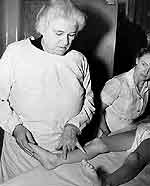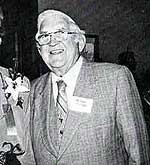By Dan Olson
Minnesota Public Radio
August 22, 2002
| |
|
|
|
||
Henry Haverstock, Jr. was a south Minneapolis teenager when polio struck him in 1939. He was immediately given the standard treatment. He was put in bed and immobilized with casts and braces.
Haverstock's father was a wealthy Minneapolis attorney, who spared no expense trying to get his son back on his feet. He sent him to Warm Springs, the Georgia treatment center made famous because President Roosevelt had used the mineral baths there in a futile bid to regain mobility.
Haverstock showed no improvement.
Months after contracting polio - lying in his bed, fitted with braces - Haverstock remembers his father ushering a tall, broad-shouldered older woman with snow-white hair into his upstairs bedroom. Elizabeth Kenny asked Haverstock to carry his son to the dining room table, where she examined him.
"She showed how I couldn't even be forced into a sitting position with my legs ahead of me because these braces had caused what she called a spasm. I was stiff," Haverstock said.
Kenny told Haverstock's father if he wanted her to treat his son, the braces would have to go. Haverstock became one of Elizabeth Kenny's first U.S. patients. Within weeks of starting her treatment he was walking.
| |
|
|
|
||
Kenny's big break came when three University of Minnesota physicians, intrigued by her results, arranged a lecture. She was late. Dozens of physicians waited for her to appear.
One of them was the late Dr. Milan Knapp. In a 1987 interview, he recalled that Kenny arrived and complained about the dismal treatment she'd received.
"She gave a two-hour lecture, and the first hour and a half was griping about the treatment that she'd been receiving from all the doctors, not only in the United States, but England and elsewhere too," he said.
Knapp was a prominent physician at the University of Minnesota and Minneapolis General Hospital. He remembers, after Kenny finished her harangue, that she used words he'd never heard connected with polio - muscle spasm, incoordination, mental alienation - Kenny's own terminology.
Knapp was skeptical, but hungry for any treatment that showed a glimmer of hope for people immobolized in casts and braces. He took Kenny to see one of his patients, a grocer's son. Kenny examined his paralyzed limbs, recommended hot packs to relieve the muscle stiffness and her physical therapy to restore movement.
| |
|
|
|
||
The treatment worked. The boy recovered. Knapp was a convert. He gave Kenny permission to treat patients at Minneapolis General Hospital. He kept records of the results.
"Fifty-five percent of the patients turned out what we called normal. The others had varying degrees of weakness, but all of them turned out to be pretty functional," Knapp said.
The results were like a bolt of lightening from a summer thunderstorm. Kenny was helping people - many of them children, consigned to a life with braces or a wheelchair - to walk. And she now had the support of an American physician whose credentials were beyond reproach.
However, Kenny was nearly broke from her travels. Miland Knapp let Kenny stay in his family home in Minneapolis. He used his report on her treatment results to apply for grants, but the wait for funds would be months. Even so, Kenny, with missionary-like zeal, continued to treat polio victims and took no money for her work.
A group of Minneapolis businessmen came to her financial rescue. Betty Henry, 98, remembers the fateful meeting where Kenny met Minneapolis' high rollers. Henry's husband Jim was a member of a downtown Minneapolis businessmen's club. He organized the meeting, where Kenny described her treatment to an audience willing to put their money behind someone who claimed to be able to counter the panic sown by polio.
| |
|
|
|
||
"They gave her $412 a month, which was a lot of money in the 1940s," Betty Henry said.
Henry said after the dinner meeting, her husband Jim gave Kenny a ride home.
"(Kenny) said, 'Today is the first real meal I've had in five days, outside of tea and toast.'"
Kenny's fortunes had turned, and her star began to rise. Her successful polio treatments won broad public support and grabbed headlines. She trained a corps of rehabilitation specialists in Minneapolis. Then she traveled the country, giving speeches and interviews. Eventually, Naomi Rodgers said, Kenny caught the attention of Hollywood celebrities.
"There was nothing that the media loved more than taking pictures of famous actresses having cocktails with a great nurse, and contributing their star power to helping the suffering of children," Rogers said.
Even skeptics couldn't deny Kenny's results. Doctors all over the Midwest wanted to see her techniques. That's how she met Richard Owen.
Kenny visited Indiana University to examine polio victims. One of them was Richard Owen, then 15, and still wearing braces.
Owen was wheeled into the large examining room wearing only a flimsy white cotton loincloth. He was surrounded by medical school faculty and photographers snapping away as Elizabeth Kenny examined him.
"She untied the lower string on both sides of my loincloth and sort of flipped them over, and the cameras were clicking and I thought, 'Oh my goodness.'" he said.
To Owen's enduring relief, none of the Indianapolis newspapers carried any pictures of his moment of fame. He began the Kenny treatment, and for the first time in three years he was able to walk without braces.
More from MPR



